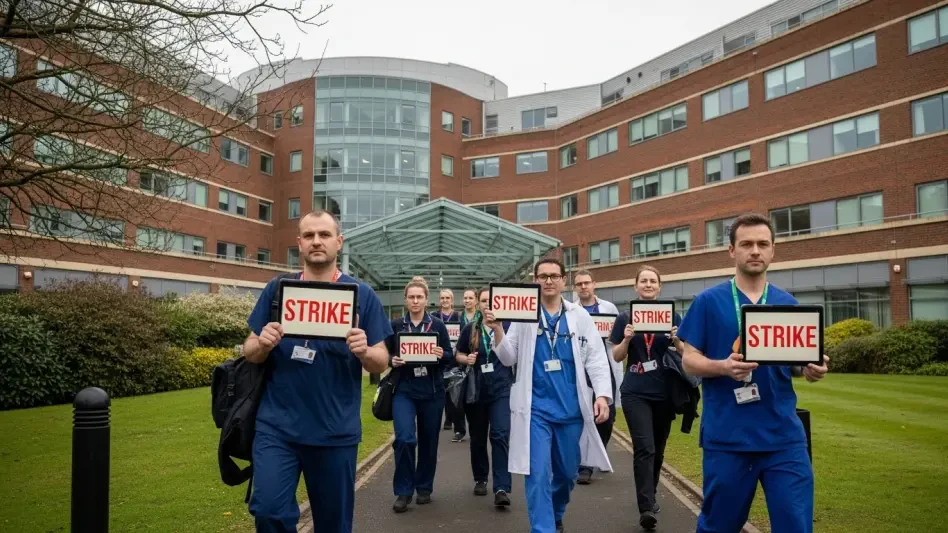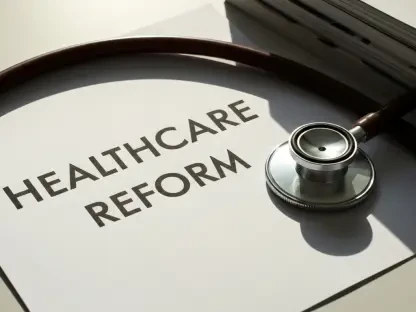The U.S. healthcare system stands at a critical crossroads as 31,000 Kaiser Permanente workers in California and Hawaii launch a five-day strike, spotlighting deep-seated issues of understaffing, wage disparities, and patient care quality. This labor action, driven by members of the United Nurses Associations of California/Union of Health Care Professionals (UNAC/UHCP), underscores a growing unrest among healthcare professionals grappling with post-pandemic challenges. With Kaiser Permanente operating as one of the nation’s largest health systems, serving millions of patients, the stakes of this dispute ripple far beyond its facilities. This roundup gathers diverse perspectives from union representatives, industry analysts, healthcare executives, and labor experts to unpack the motivations behind the strike, the systemic issues at play, and the potential impact on the future of healthcare labor relations. The aim is to provide a comprehensive view of this pivotal moment through varied lenses.
Exploring the Roots of the Strike: Why Now?
Union Perspectives on Workplace Struggles
Union voices paint a stark picture of deteriorating conditions at Kaiser facilities, emphasizing chronic understaffing as a primary grievance. Representatives argue that the loss of significant portions of staff has led to unsustainable workloads, directly threatening patient safety with longer wait times and compromised care. Beyond mere numbers, the emotional toll on workers—burnout and stress—fuels their resolve to demand systemic change rather than temporary fixes during contract negotiations.
Another layer of frustration centers on stalled talks with management, particularly around the dignity and respect workers feel are lacking. Union advocates stress that the strike is not solely about financial gain but about ensuring a workplace environment where healthcare professionals can deliver quality care without being stretched to their breaking points. This perspective frames the action as a necessary stand for both employees and the patients they serve.
Industry Analysts on Broader Healthcare Trends
Industry analysts contextualize this strike within a larger wave of labor unrest sweeping through healthcare since the pandemic’s peak. They highlight how systemic issues like administrative overload and persistent staffing shortages have created a pressure cooker for frontline workers across the nation, not just at Kaiser. The consensus among these observers is that such disputes signal a tipping point where healthcare labor can no longer ignore the cumulative strain of recent years.
Differing slightly, some analysts point to the unique position of Kaiser as a financially robust system, suggesting that its substantial revenue and reserves amplify the perceived inequity when workers’ demands go unmet. This view raises questions about whether large health systems are equipped—or willing—to address labor concerns without external pressure like strikes, setting the stage for ongoing conflicts if structural reforms lag behind.
Core Issues Fueling the Dispute: What’s at Stake?
Understaffing and Patient Safety Concerns
Union accounts consistently underscore understaffing as a critical threat, with reports of significant staff losses leading to overworked teams and care delays. They argue this issue isn’t just about worker fatigue but about the very foundation of safe healthcare delivery, pushing them to strike as a public alert to these dangerous gaps. Their stance is that without contractual guarantees for adequate staffing, the cycle of strain will persist.
On the flip side, insights from healthcare management consultants suggest that while staffing shortages are real, striking may not be the most effective solution due to immediate disruptions in patient care. They propose that collaborative task forces between unions and management could better address root causes like recruitment challenges without risking service interruptions, though they acknowledge the urgency workers feel to act now.
A third angle from patient advocacy groups emphasizes the end impact on those receiving care, expressing concern over how strikes exacerbate existing delays. While sympathetic to workers’ plights, these groups caution that the public’s trust in healthcare systems could erode if such actions become frequent, urging both sides to prioritize dialogue over confrontation.
Wage Disparities Amid Economic Pressures
The wage debate reveals a sharp divide, with union sources arguing that Kaiser’s offer of a 21.5% raise over four years falls short of their 25% demand, especially given inflation’s impact and stagnant pay for newer staff. They juxtapose this with Kaiser’s massive financial reserves and executive compensation, framing the gap as a matter of fairness rather than mere economics. Their position is clear: frontline workers deserve priority over corporate profits.
Contrasting this, financial analysts within the healthcare sector note that the additional cost of meeting union demands—potentially $300 million annually by the contract’s end—could force rate hikes for patients. They argue that Kaiser’s fiscal responsibility to millions of members necessitates a cautious approach to wage increases, even if reserves appear substantial. This perspective highlights the delicate balance between worker compensation and broader affordability.
Labor economists offer a middle ground, suggesting that while wage hikes are justified given inflation, health systems must transparently communicate how such costs impact operations. They advocate for tiered increases or performance-based incentives as potential compromises, warning that unresolved wage disputes could trigger further unrest across similar organizations if workers feel perpetually undervalued.
Corporate Accountability and Financial Priorities
Union critiques zero in on Kaiser’s $115.8 billion revenue and investments in controversial sectors like fossil fuels, questioning why such funds aren’t redirected to staffing and wages. This viewpoint casts the health system’s priorities as misaligned with its mission of patient-centered care, fueling accusations of profit over people. The strike, in this light, becomes a demand for ethical realignment.
Healthcare executives, speaking generally on industry practices, counter that labor costs are only one piece of a complex financial puzzle, with drug prices and systemic inefficiencies driving rate increases more than wages. They defend large reserves as necessary for long-term stability, arguing that diverting investments to immediate labor demands risks future operational challenges. This stance calls for patience and broader cost reforms.
Policy analysts add nuance by suggesting that government oversight could play a role in ensuring health systems like Kaiser balance profit with worker and patient needs. They point to potential regulations around reserve allocations or transparency in executive pay as mechanisms to address union concerns without destabilizing finances, though they note such changes would require time and political will.
Impact on Care Delivery During the Strike
Union members acknowledge the operational disruptions caused by the strike but argue that pre-existing care gaps due to understaffing are the true issue, not their protest. They highlight personal sacrifices, like forgoing pay, as evidence of their commitment to forcing change, framing the action as a critical signal of systemic flaws. Their hope is that public awareness will pressure management to act.
Kaiser’s response, as interpreted by operational consultants, focuses on maintaining services through virtual care, rescheduling procedures, and hiring temporary staff. These experts suggest that while Kaiser labels the strike as unnecessary, its contingency plans demonstrate an awareness of the need to mitigate patient impact. However, they question whether such measures address the underlying grievances or merely manage short-term optics.
Patient feedback, gathered from community forums, reveals mixed sentiments about the strike’s effects, with some expressing frustration over delayed appointments while others support workers’ fight for better conditions, believing it ultimately benefits care quality. This split underscores the ethical tension of balancing protest rights with uninterrupted healthcare access, a dilemma both sides must navigate.
Key Takeaways from Diverse Voices
Synthesizing these perspectives reveals a multifaceted conflict where understaffing, wage equity, and corporate accountability stand as the pillars of the 31,000-worker strike at Kaiser. Union advocates push for immediate, systemic fixes to protect both staff and patients, while industry and financial experts caution against hasty solutions that could burden healthcare costs. Patient and policy voices add layers of concern and potential compromise, emphasizing the need for sustainable resolutions.
A recurring theme across all viewpoints is the recognition of post-pandemic labor tensions as a driving force, with burnout and dissatisfaction echoing beyond Kaiser to the broader healthcare landscape. While opinions differ on the strike’s necessity and approach, there’s a shared understanding that ignoring these issues risks long-term damage to worker morale and patient trust. The diversity of insights highlights the complexity of aligning worker needs with organizational and public priorities.
Reflecting on the Path Forward
Looking back, the discourse surrounding the Kaiser Permanente strike illuminated critical fault lines in healthcare labor relations, revealing how deeply systemic challenges like staffing shortages and wage disputes impacted both workers and patients. The clash of perspectives—from union passion to executive pragmatism—underscored the urgency of addressing these issues before they escalated further across the industry.
Moving ahead, actionable steps emerged as vital considerations, such as fostering transparent negotiations between health systems and unions to prevent future unrest. Stakeholders were encouraged to explore contractual commitments for staffing levels and tiered wage adjustments as potential bridges over divisive gaps. Additionally, staying informed on healthcare labor policies and advocating for worker-supportive reforms offered practical ways for the public to engage with this ongoing struggle, ensuring that the lessons from this strike paved the way for a more equitable healthcare future.









